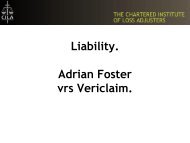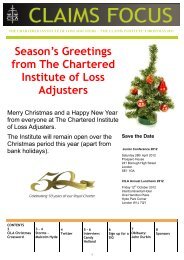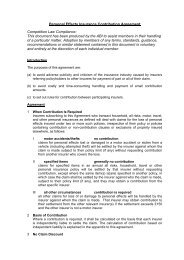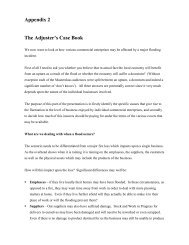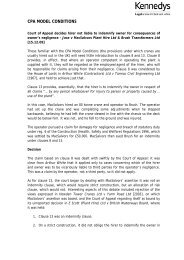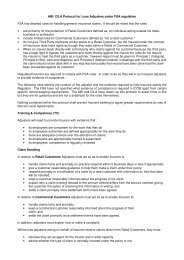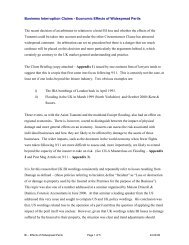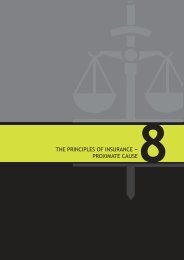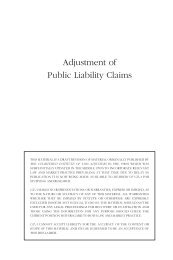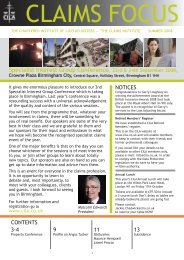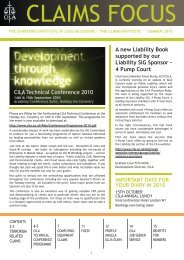a briefing note from michael whitton of edwin coe llp - CILA/The ...
a briefing note from michael whitton of edwin coe llp - CILA/The ...
a briefing note from michael whitton of edwin coe llp - CILA/The ...
You also want an ePaper? Increase the reach of your titles
YUMPU automatically turns print PDFs into web optimized ePapers that Google loves.
A BRIEFING NOTE FROM MICHAEL WHITTON OF EDWIN COE LLP<br />
_______________________________<br />
DEPRECIATION – A MISSED OPPORTUNITY<br />
______________________________<br />
1. <strong>The</strong> appeal in Synergy Health (UK) Limited –v- CGU Insurance Plc (t/a Norwich Union) and<br />
Others arose in relation to a Judgment <strong>of</strong> Mr Justice Flaux dated 19 October 2010. <strong>The</strong> case<br />
related to a claim against Synergy’s insurers for damages in respect <strong>of</strong> loss and damage<br />
sustained in a fire at its premises at Dunstable on 3 February 2007. At those premises,<br />
Synergy maintained a linen management facility, washing and preparing linen for use by the<br />
NHS. It was insured against material damage and business interruption losses but insurers<br />
declined to indemnify Synergy on the grounds <strong>of</strong> material non disclosure and/or<br />
misrepresentation in failing to correct a representation that a burglar alarm would be installed<br />
by the end <strong>of</strong> 2006.<br />
2. <strong>The</strong> Judge found that there had been non disclosure/misrepresentation but that the insurers had<br />
failed to establish the relevant inducement i.e. the Judge was not persuaded that it would have<br />
made any difference to the insurers.<br />
3. As to the quantum <strong>of</strong> the business interruption loss, there was agreement between the parties<br />
save in relation to two issues. <strong>The</strong> first related to increased cost <strong>of</strong> spare parts which is not<br />
relevant for the purpose <strong>of</strong> this <strong>note</strong>. <strong>The</strong> second issue related to the treatment <strong>of</strong> depreciation<br />
on the damaged plant and machinery. Depreciation was not treated in the same way after the<br />
fire as it was before the fire. <strong>The</strong>refore it was argued by the insurers that there was a saving <strong>of</strong><br />
the depreciation expense which had to be taken into account because the saving reduced the<br />
loss that Synergy suffered.<br />
4. In summary, the basis <strong>of</strong> the Judge’s findings was that:<br />
(i)<br />
(ii)<br />
As a matter <strong>of</strong> principle, the fact that during the indemnity period a deduction for<br />
depreciation ceased to be made, meant that there was a saving which ought to be<br />
brought into account when quantifying the business interruption losses;<br />
As a matter <strong>of</strong> construction <strong>of</strong> the policy, although the saving provision referred to<br />
savings “in respect to such <strong>of</strong> the charges and expenses <strong>of</strong> the Business payable out<br />
<strong>of</strong> Gross Pr<strong>of</strong>it as may cease or be reduced in consequence <strong>of</strong> the incident” and<br />
depreciation was not actually paid or payable, the meaning <strong>of</strong> “payable out <strong>of</strong> Gross<br />
2070350_1 1
Pr<strong>of</strong>it” was not limited to a literal interpretation <strong>of</strong> “payable” but embraced the sort<br />
<strong>of</strong> charges or expenses which would ordinarily be deductible <strong>from</strong> Gross Pr<strong>of</strong>it.<br />
5. <strong>The</strong> Judge gave permission to appeal on 17 November 2010 because in his view:<br />
(i)<br />
(ii)<br />
<strong>The</strong> appeal had a real prospect <strong>of</strong> success; and<br />
<strong>The</strong> point relating to depreciation was one which had troubled the insurance industry<br />
for some time and on which an authorative ruling <strong>from</strong> the Court <strong>of</strong> Appeal would be<br />
welcome.<br />
At its heart, the issue was whether or not depreciation, which in the ordinary course <strong>of</strong><br />
business:<br />
(i)<br />
(ii)<br />
Is treated as an annual expense <strong>of</strong> the business, recorded in the pr<strong>of</strong>it and loss<br />
accounts; and<br />
Shown in the balance sheet as a reduction in the asset value <strong>of</strong> the company;<br />
should be treated as a saving (i.e. as actually not having been incurred) because after the fire,<br />
depreciation was not shown in the management accounts as it had been before the fire. <strong>The</strong><br />
business was not operative <strong>from</strong> the fire damaged premises for a period <strong>of</strong> 10 months after the<br />
fire and the insurers claimed that, since depreciation was not shown in the management<br />
accounts for that period, that represented a saving and should be deducted <strong>from</strong> the increased<br />
cost <strong>of</strong> working for which Synergy was entitled to an indemnity.<br />
6. <strong>The</strong> policy wording was relatively standard and, after the usual provisions for calculating the<br />
reduction in Turnover and increase in cost <strong>of</strong> working, concluded with:<br />
“less any sums saved during the Indemnity period in respect <strong>of</strong> such <strong>of</strong> the charges and<br />
expenses <strong>of</strong> the Business payable out <strong>of</strong> Gross Pr<strong>of</strong>it as may cease or be reduced in<br />
consequence <strong>of</strong> the incident.”<br />
7. It was Synergy’s case that depreciation is an accounting means <strong>of</strong> recognising, on an annual<br />
basis, the amortised cost <strong>of</strong> plant and machinery, the cost <strong>of</strong> which has been incurred at an<br />
earlier time. <strong>The</strong> total cost <strong>of</strong> purchase is not set <strong>of</strong>f against turnover in the year <strong>of</strong> purchase<br />
but spread over the expected useful lifetime <strong>of</strong> the plant and machinery and recorded as an<br />
annual expense to reflect the fact that the pr<strong>of</strong>it is derived <strong>from</strong> the use <strong>of</strong> plant and machinery<br />
which has an expected lifetime <strong>of</strong> X years. <strong>The</strong> cost is actually incurred on the acquisition <strong>of</strong><br />
the plant and machinery.<br />
2070350_1 2
8. Damage to the plant and machinery makes no difference to the fact that the cost <strong>of</strong> the plant<br />
and machinery has already been incurred or to the fact that, whatever that cost was, it is then<br />
treated in the accounts as being depreciated annually until the end <strong>of</strong> its useful life by which<br />
time the full cost <strong>of</strong> the plant and machinery will have been set <strong>of</strong>f against the gross pr<strong>of</strong>it<br />
made by Synergy.<br />
9. In the case <strong>of</strong> plant and machinery which is not damaged, the end <strong>of</strong> its working life will mean<br />
for the whole <strong>of</strong> the period <strong>of</strong> the expected use <strong>of</strong> the plant and machinery. In the case <strong>of</strong><br />
plant and machinery which is damaged so as to be written <strong>of</strong>f, it will be brought to an<br />
unexpected and premature end <strong>of</strong> its working life by that damage. <strong>The</strong> residual value <strong>of</strong> the<br />
equipment in the accounts (after earlier depreciation) has to be dealt with.<br />
10. If the useful working life <strong>of</strong> the plant and machinery is brought to an abrupt end it becomes<br />
valueless and the whole <strong>of</strong> its remaining value is depreciated in one operation or written <strong>of</strong>f<br />
(rather than continuing to depreciate on a straight line basis). Thus the depreciation which<br />
would have occurred in normal circumstances over the 10 month period following the fire, has<br />
in fact been absorbed within the write <strong>of</strong>f <strong>of</strong> tangible fixed assets. This also includes the write<br />
<strong>of</strong>f <strong>of</strong> the remaining cost in the pr<strong>of</strong>it and loss account and the write down <strong>of</strong> the remaining<br />
value in the balance sheet. Far <strong>from</strong> being saved, therefore, the depreciation has been<br />
incurred.<br />
11. Another way <strong>of</strong> analysing the treatment is that the depreciation charge has to be accelerated to<br />
accommodate the change <strong>from</strong> the plant and machinery being expected to have a continuing<br />
working life and diminishing value for several years with depreciation being taken annually<br />
and it unexpectedly reaching the end <strong>of</strong> its working life when a one <strong>of</strong>f depreciation charge <strong>of</strong><br />
the remaining balance <strong>of</strong> the value <strong>of</strong> the plant and machinery is taken to deal with the<br />
unexpected loss <strong>of</strong> value.<br />
12. Accordingly, Synergy’s principal arguments against the Judge’s finding that depreciation<br />
should be deducted as a saving were:<br />
(i)<br />
(ii)<br />
That the true characteristic <strong>of</strong> depreciation is an accounting entry recording, as a<br />
charge or expense, a proportion <strong>of</strong> the cost price <strong>of</strong> assets which have already been<br />
acquired.<br />
That the charge or expense is generally calculated by taking the cost price <strong>of</strong> the asset<br />
and dividing that price by the number <strong>of</strong> years <strong>of</strong> useful working life the asset is<br />
projected to have.<br />
2070350_1 3
(iii)<br />
(iv)<br />
(v)<br />
(vi)<br />
(vii)<br />
That the cost price or the liability for the cost price having been incurred, the process<br />
<strong>of</strong> spreading the cost across many years (amortising) is continued until there is a total<br />
reduction in value, either by the plant and equipment reaching the end <strong>of</strong> its working<br />
life or being unexpectedly brought to the end <strong>of</strong> its working life.<br />
<strong>The</strong> more usual treatment <strong>of</strong> the cost <strong>of</strong> the plant and equipment where the plant and<br />
equipment has come to the unexpected and premature end <strong>of</strong> its useful working life,<br />
is to write <strong>of</strong>f the undepreciated cost <strong>of</strong> the damaged assets in the pr<strong>of</strong>it and loss<br />
account and to reflect the write down <strong>of</strong> the residual value <strong>of</strong> the asset in the balance<br />
sheet.<br />
That is what happened in this case. <strong>The</strong> depreciation, which might have been<br />
expected to be ongoing for years over the useful lifetime <strong>of</strong> the plant and machinery,<br />
was accelerated and an appropriate element <strong>of</strong> the value <strong>of</strong> tangible fixed assets was<br />
written <strong>of</strong>f as a result <strong>of</strong> the fire.<br />
<strong>The</strong> expected annual depreciation for plant and equipment in its undamaged state,<br />
was in fact included within the sum written <strong>of</strong>f. <strong>The</strong> expected annual depreciation<br />
would have represented a write down <strong>of</strong> part <strong>of</strong> the residual value <strong>of</strong> the plant and<br />
equipment (which came to be damaged), whereas the actual write <strong>of</strong>f represented a<br />
write down <strong>of</strong> the whole <strong>of</strong> the residual value. <strong>The</strong> partial write down (the norm) and<br />
the whole write down (the exception) were different only in scale, but otherwise were<br />
the same, since each represented a reduction in the value <strong>of</strong> the same equipment.<br />
<strong>The</strong> result was that the depreciation actually charged in the accounts as a result <strong>of</strong> the<br />
damage, was very much greater than the depreciation which would have been<br />
charged if there had been no damage. Far <strong>from</strong> there being a saving, the depreciation<br />
charge or expense was greater than it would have been.<br />
13. In relation to the Judge’s finding that the meaning <strong>of</strong> the words “payable out <strong>of</strong> Gross Pr<strong>of</strong>it”<br />
included “depreciation” because the word “payable” should be construed broadly so as to give<br />
it the meaning <strong>of</strong> a “charge” or “expense”, Synergy’s principal arguments were:<br />
(i)<br />
That it was wrong to find that “payable” was to be construed as meaning “a charge”<br />
or “an expense” because depreciation is an accounting entry which recognises the<br />
spreading <strong>of</strong> cost which has already been paid or incurred and the reduction in value<br />
<strong>of</strong> the plant and equipment over its lifetime. Depreciation is not the payment <strong>of</strong><br />
anything. Depreciation is not paid to anybody. It is not paid anywhere. Payment<br />
occurred when the plant and equipment was bought.<br />
2070350_1 4
(ii)<br />
(iii)<br />
<strong>The</strong> cost <strong>of</strong> acquisition which had been incurred (and the value which had been<br />
acquired) was not the subject <strong>of</strong> separate repeated transactions involving the payment<br />
<strong>of</strong> money, which were reflected in the accounts according to whether the plant and<br />
equipment could be used. <strong>The</strong> cost, having been incurred, was spread over a period<br />
<strong>of</strong> time, and whether the plant and equipment was damaged or undamaged, that cost<br />
(and the reduction in value <strong>of</strong> the plant and equipment) was to be reflected in the<br />
accounts as an accounting entry, either as an annual deduction or, as a write <strong>of</strong>f if the<br />
circumstances required. <strong>The</strong> cost or its accounting treatment did not cease, merely<br />
because the equipment was no longer useable. In no sense could that accounting<br />
entry be regarded as a saving, merely because the plant and equipment was no longer<br />
usable.<br />
Depreciation is different <strong>from</strong> other charges and expenses in the Pr<strong>of</strong>it and Loss<br />
account, which are commonly taken as savings, because it cannot be realised. Other<br />
savings (electricity, soap powder etc.) are costs which the insured does not pay and<br />
are therefore deducted <strong>from</strong> the increased cost <strong>of</strong> working and <strong>from</strong> the claim. That<br />
is a neutral adjustment for the insured. However, depreciation “savings” cannot be<br />
realised in the same way, with the result that if such “savings” are deducted, the<br />
insured suffers an unjustified loss in the assessment <strong>of</strong> the quantum <strong>of</strong> the claim.<br />
Conclusion<br />
14. Sadly for the insurance industry, the appeal settled and these arguments were never aired in<br />
open court. <strong>The</strong> settlement was on terms <strong>of</strong> a payment to Synergy for whom continuing the<br />
appeal became commercially pointless but the payment was <strong>of</strong> sufficient magnitude to<br />
indicate how insurers anticipated the Court <strong>of</strong> Appeal would decide the matter.<br />
Michael Whitton<br />
Partner Edwin Coe LLP<br />
Sponsors <strong>of</strong> the Claimant SIG<br />
January 2012<br />
2070350_1 5



